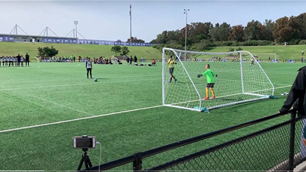Bending over backwards to pat yourself on the back might just snap your spine.
Despite their sedentary choice of profession, or more likely because of it, writers are notorious for having bad backs. It’s all those hours hunched over keyboards and curled up reading that tends to do it.
As a frustrated writer of rather dubious talent myself, I have also experienced my fair share of back trouble. At times it has become so inhibiting that in social settings I must decline invitations to sit down. As a result, I can often find myself very literally standing out from the crowd.
So, with both my familiarity with recurrent back pain and tendency to be the odd one out firmly established, I feel compelled to impart some timely advice to the A-League marketing machine in the wake of last weekend’s record attendance figures – if you bend over backwards to pat yourself on the back you just might snap your spine.
While it is true that last weekend’s inaugural rivalry round set a cumulative attendance record, and it is also true that this season’s opening round was the best attended since the A-League’s first season, I am finding it incomprehensible that those who should know better cannot see this outcome for the contrivance it so clearly is.
Whether you view it as a gentle massage or as more of a back-cracking chiropractic realignment, the A-League has made no secret that it has manipulated and contorted the match schedule to produce such an outcome.
In the space of three weeks we have seen three geographic derbies, a grand final rematch and back-to-back grudge matches involving, in way or another, all five represented capital cities.
Granted, there is little doubt that this alternative approach to scheduling has been somewhat successful – the A-League’s seventh season has lost the slightly stooped appearance of recent season starts and is currently walking tall.
However, the question remains will these measures have a lasting effect or are they merely a temporary solution? Further to that, will the league still be posturing so proudly in another three weeks following a series of less spine-tingling fixtures?
Without wanting to be pessimistic, I believe the A-League should be braced for a pronounced slump in attendances over the coming rounds. It won’t be enough to cripple the competition’s feel-good start but it will constitute a much needed reality check.
Now that the first instalments of the derbies and rivalries that usually comprised the backbone of the season, previously spaced at regular intervals like vertebrae that provided rigidity and strength to the weaker parts of the schedule, have been completed, a more accurate picture of A-League attendances will begin to emerge.
The fact remains that despite the records, these crowds viewed individually, whilst certainly encouraging, aren’t unto themselves record breaking. Even the much lauded rivalry round did not result in a single club bettering the attendance of its season opener.
Let me briefly lumber you with some statistics. The opening fifteen games had an average attendance of around fifteen thousand, yet only three of these matches actually topped that figure – two of which were Melbourne Victory home games that attracted approximately forty thousand fans each.
If league-wide average attendances should ideally have a near normal distribution and thereby somewhat begin to resemble a bell curve, then this one should be diagnosed with a serious case of scoliosis.
Clearly if it weren’t for the football fanatics of Melbourne once again doing the heavy lifting – remember to bend at the knees and not the waist there, lads – there wouldn’t be any records of which to speak right now.
This harsh truth also means there will be no records of which to speak in the coming rounds.
With Victory on the road for two of the next three weeks, and with perennial attendance slouches Gold Coast United hosting two games over the same period, it is likely that attendance figures will return to some semblance of normality before the back-slappings in the A-League offices have even ceased to sting.
That is why I think the congratulations that has accompanied the early season turn out is disproportionate. And if I’m the only one with enough backbone to say it, then so be it.
I’d rather be the odd one out than another spineless ‘yes’ man handing out the kudos before they are truly earned. Because ultimately I suspect it will take back-breaking endeavour rather than simple gimmicks to permanently cure the A-League's attendance ills.
Related Articles

Fresh talent flock to ambitious A-League outfit's pro pathway

Why A-League 20/21 is crucial for Olyroos’ medal hopes













